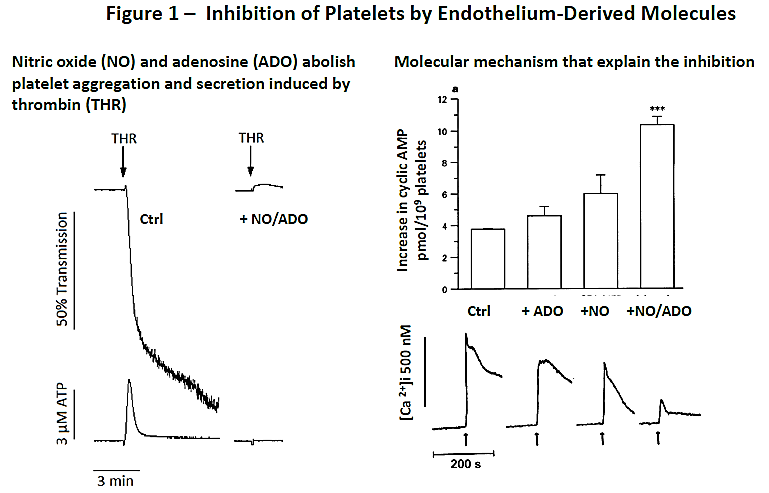Cross-talk between platelets and the vessel wall
About this project
Project information
Particular emphasis has been directed towards the role of endothelium-derived nitric oxide (NO), prostaglandin I2 (PGI2), and adenosine in taming of human blood platelets. It has been shown by us and others that concomitant exposure of platelets to NO and adenosine/PGI2 provokes a strong, synergistic inhibition of human platelets (Fig. 1). These findings most likely reflect the importance of a functional and health endothelium to keep circulating platelets in a dynamic resting state. From pharmacological perspectives, it would be a great progress to utilize the power of NO and PGI2 to control misdirected platelet activation. Ongoing research aims to identify new molecular targets for NO-releasing drugs and reveal more precise mechanisms by which NO combined with adenosine/PGI2 suppress human platelets.

Fig. 1 Inhibition of platelets by NO and adenosine. Thrombin (the most powerful activator of human platelets) provokes complete aggregation and dense granule secretion (left traces). Mimicking the endothelium by co-stimulation of platelet with a NO-releasing drug and adenosine abrogates platelet activation by thrombin (Grenegård et al 1996, Asplund Persson et al 2005; key publications no 8 and 12). The underlying mechanisms comprise NO/cyclic GMP-mediated inhibition of phosphodiesterase class III leading enhanced cyclic AMP response (top right) as well as strong inhibition of thrombin-induced Ca2+ mobilization (bottom right).
Key Publications
- Differentiation of human dermal fibroblasts towards endothelial cells. Differentiation. 2013.
- A novel role of phospholipase D as an endogenous negative regulator of platelet sensitivity. Cell Signal. 2012.
- Hyaluronic acid influence on platelet-induced airway smooth muscle cell proliferation. Exp Cell Res. 2012.
- Protease-activated receptor 1 (PAR1) signaling desensitization is counteracted via PAR4 signalling in human platelets. Biochem J. 2011.
- Alpha 1-acid glycoprotein (AGP)-induced platelet shape change involves the Rho/Rho kinase signalling pathway. Thromb & Haemost. 2009.
- The ATP-gated purinergic P2X1 receptor plays a pivotal role in activation of aspirin-treated platelets by thrombin and epinephrine. J Biol Chem. 2008.
- The acute-phase protein alpha1-acid glycoprotein (AGP) induces rises in cytosolic Ca2+ in neutrophil granulocytes via sialic acid binding immunoglobulin-like lectins (Siglecs). FASEB J. 2007.
- Cross-talk between adenosine and the oxatriazole derivative GEA 3175 in platelets.Eur J Pharmacol. 2005.
- Nitric oxide inhibits gastric acid secretion by increasing intraparietal cell levels of cGMP in isolated human gastric glands. Am J Physiol. 2005.
- Synergistic activation of human platelets by lysophosphatidic acid and adrenaline. Haematologica. 2002.
- Release of oxygen metabolites from chemoattractant-stimulated neutrophils is inhibited by resting platelets: role of extracellular adenosine and actin polymerization. Blood. 1996.
- Synergistic inhibition of thrombin-induced platelet aggregation by the novel nitric oxide-donor GEA 3175 and adenosine. Br J Pharmacol. 1996.
Contacts
Professor Magnus Grenegård magnus.grenegard@oru.se
Researcher Knut Fälker knut.falker@oru.se


